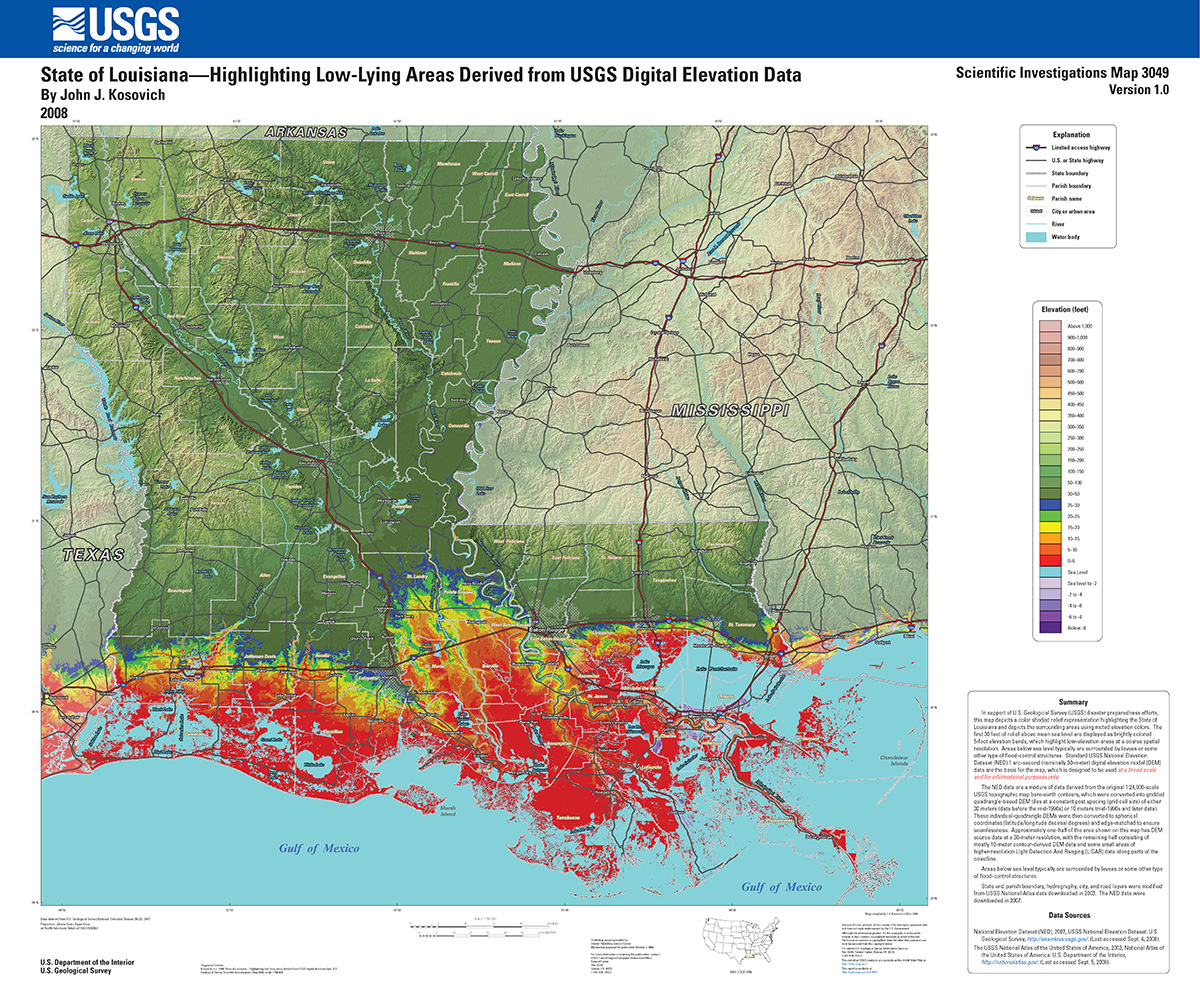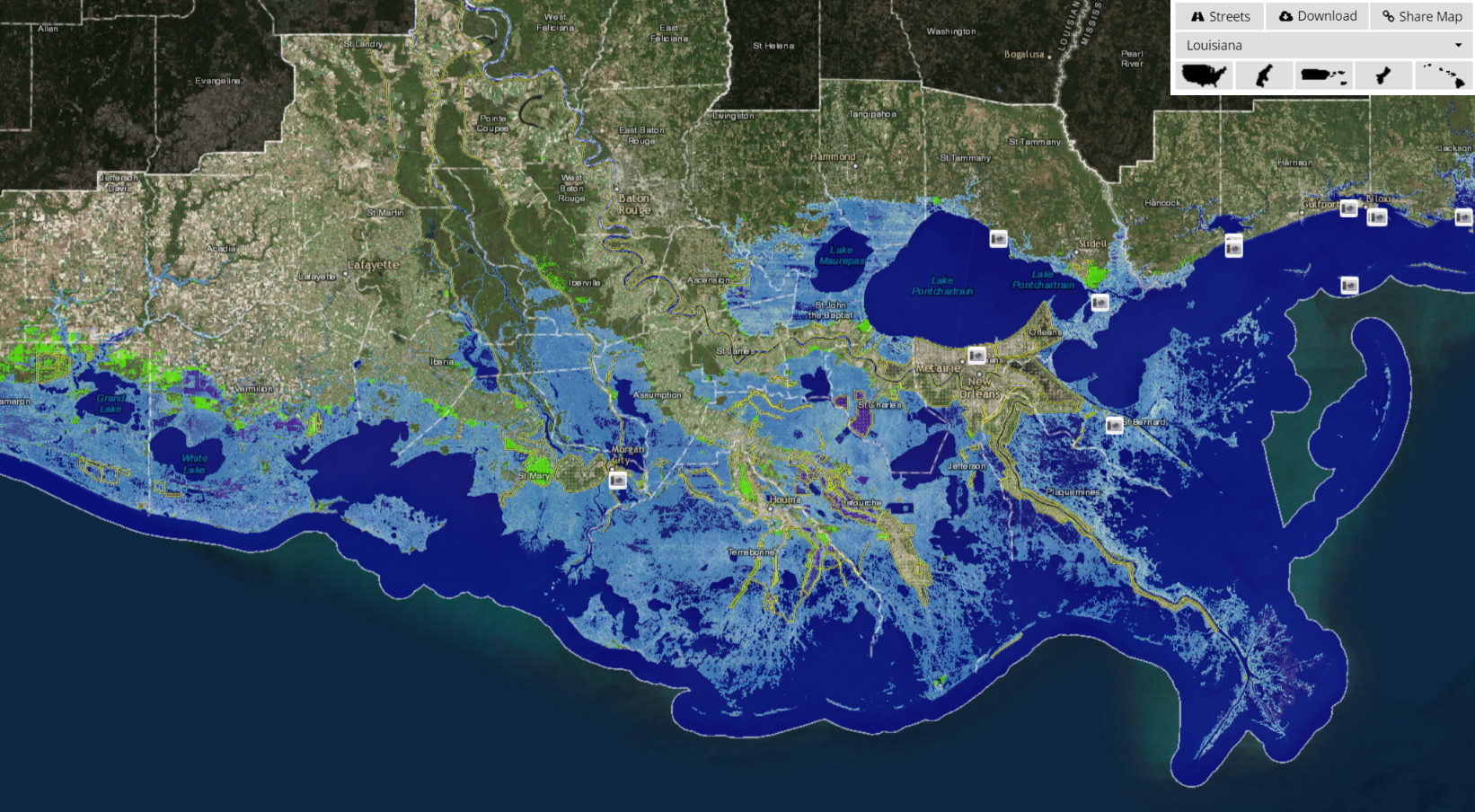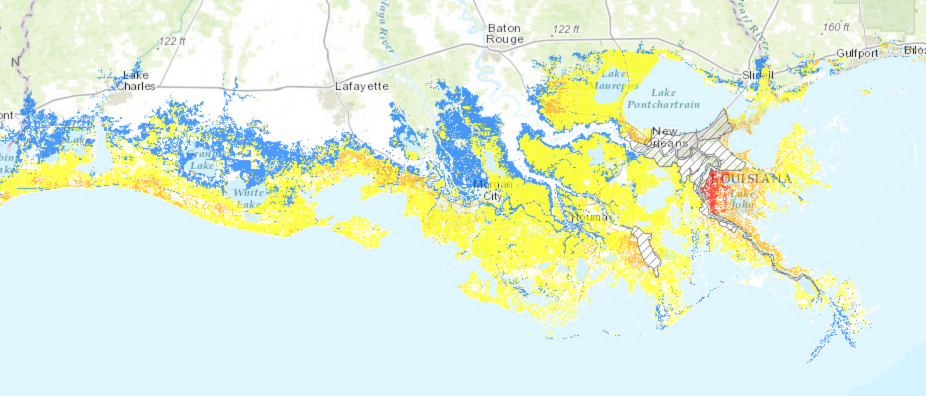Coastal Louisiana is disappearing into the Gulf of Mexico. While the media focuses on the loss of land, polls of residents indicate that the real concern is the flood risk to the communities, farms, and businesses in southern Louisiana. The Louisiana Coastal Preservation and Restoration Authority has just rolled out the 2017 Coastal Master Plan. The Master Plan proposes using dredging and river diversions to build on the edges of the coast in areas of open water. The goal is to reduce the flood risk by slowing the overall loss of land. Many scientists question whether this land can be built, how long it will last, and the financial and environmental costs of trying to build it. It is not necessary to resolve these scientific controversies because slowing the overall loss of land will not protect communities, farms, and businesses from hurricane surge and the day to day flooding driven by sea level rise and subsidence.
The estimated cost of the Master Plan range from $50-100 billion or more, over a 50 year time period. Recognizing the scientific uncertainty about the proposed projects, the proponents of the Master Plan argue that it is better to do something than nothing, that we are no worse off if the projects do not work. But time and money are limited. The tens of billions of dollars that are proposed for Master Plan projects would be better spent on other projects that would provide real and immediate protection, such as maintaining existing levees. This would make coastal communities safer and buy time for longer term strategies to migrate away from the coast.
Elevation and flood risk
The most important risk factor for flooding is elevation. Most of the Louisiana coast has been shaped by the Mississippi River delta. It is flat and low. The low coastal elevation is shown by the topographic map of coastal Louisiana (full size image):
The areas in red are at or below 5 feet of elevation. This map shows the actual elevations both outside and inside of the levees. Much of this land is at or less than 1 foot above sea level, as show in the NOAA Sea Level Rise Viewer set to one foot sea level rise:
The light blue areas are land that is at or less than one foot of elevation. Half of New Orleans is below sea level, with some areas as much as 10 feet below sea level. All of this land would be flooded if there were no levees.
The major threat to coastal Louisiana is storm surge flooding from winter storms and hurricanes. This is best seen using NOAA’s Storm Surge Inundation (SLOSH Maximum of Maximums – MOM) visualization tool. In the MOM simulation, model hurricanes are run ashore in different directions, at varying intensity up to the maximum for the simulation, and at different speeds. The maximum depth of the water for each storm is recorded at every point. The maximum depth reached at any point by any storm is then plotted on the map. No single storm could flood all the coast to the maximum depth, but for every point there is at least one hypothetical storm that will flood the point to the plotted depth.
This is the MOM map for a category 1 hurricane:
|
||
|
||
|
||
|
While the model uses hurricane categories for different size storms, NOAA explains that many factors influence surge. The diameter of the storm and other factors are more important than wind speed, which is the only factor that is measured by the category. For example, Hurricane Isaac came ashore as a category 1 storm. It produced an 11 foot surge on Shell Beach, on the coast south and east of New Orleans. It caused significant flooding and damage in Plaquemines Parish, but caused limited flooding and damage in Morgan City. Many coastal areas are now being flooded by winter storms which are much smaller than hurricanes.
Bigger storms flood farther inland. The most extreme events are the category 5 storms. (Hurricane Katrina was a category 3 when it came ashore, but developed a high surge because it was a very wide storm.) This is the MOM map for category 5 storms:
This map shows that all of coastal Louisiana outside of levees can be under at least 9 feet of water with the right category 5 hurricane. (The simulation assumes that levees will not break or be over-topped, but models show that even a slow moving category 3 hurricane can over-top the levees.)
Why didn’t the wetlands stop the surge?
Neither map shows any areas that are protected from surge by wetlands. The water pushes inland over low lying land until it is blocked by rising elevation. Coastal wetlands do not create a “horizontal levee” that blocks the storm surge. Under some conditions, wetlands can reduce low surge in fast moving storms, but in other cases, wetlands can increase surge. (Resio and Westerink, 2008) Once wetlands such as salt marsh are underwater, they provide no more resistance to the surge. Since there is infinite water in the ocean, with enough wind and time, the surge will flood through any wetlands and reach equilibrium. Surge, especially of a slow moving storm, is like the tide. Wetlands do not stop the tide because it has time to flow through them. The case that is used most often to show that wetlands slow surge is mangroves slowing a tsunami.
Mangroves provide a dense network of branches and roots, as much as 15-20 feet tall, and extending inland for a significant distance in flat coastal areas. A tsunami is a brief, high energy pulse of water that can be many feet high. It hits the wall of mangroves and is slowed as it pushes through. (It is also piles up in front, raising the surge level.) If it was a continuous stream of water like the daily tide or a relatively slow moving hurricane, it would keep pushing through the mangroves and inland until it reached equilibrium. But a tsunami cannot do this because it runs out of time. Before it can reach its full height on the inland side of the mangroves, it is already receding.
Mangroves are the best case for wetlands reducing surge and even they are limited in the amount of protection that they can provide in a major hurricane. But the Louisiana coast is not armored with dense mangrove forests. It is a flat expanse of salt marsh grading into fresh marsh as you move inland, with estuaries cutting deeply into the coast. The shallow slope of the bottom offshore (a low reach) , combined with the hydrology of the Gulf of Mexico, causes the surge to build on the coast long before the hurricane comes ashore. The coastal wetlands may be under a meter or more of water many hours before the main surge comes ashore. The flooded wetlands provide little resistance to the main surge as the storm comes ashore, allowing it to push inland until slowed and stopped by rising elevation. In many areas of the Louisiana coast, this may be tens of miles inland. Where the coast is cut through with bays and low marsh extending far inland, the surge can much deeper inland, as shown on the MOM maps.
In the distant past, some of the coast was wooded with dense cypress forests. Such forests can slow hurricane surge. More importantly, they were markers of higher elevation. This elevation has been lost with subsidence, leaving ancient forests far under water.
Subsidence and sea level rise on the Louisiana coast
The Mississippi River has been flowing to the Gulf of Mexico for millions of years. The river shrinks during ice ages and expands when the ice melts. It jumps from channel to channel, but it stays within a roughly 200 mile wide range along the Louisiana coast. The weight of the sediment that has been deposited over the millions of years depresses the crust of the earth and creates a constant downward movement – subsidence – of the surface. The depression caused by this subsidence is called the accommodation space: it accommodates the sediment deposited by the river. As long as the river deposits enough sediment to keep the accommodation space filled, the land will stay above sea level.
When sea level is stable and there is adequate sediment in the river, the river will fill the growing accommodation space with sediment and the area around the river, called the delta lobe, will grow. The edges of the delta lobe will expand into the Gulf but will stay at sea level because water does not flow uphill. The lobe builds elevation by flooding over the banks inland from the edge, piling up sand and sediment into natural levees that grow higher and wider with each flood. Wetlands on the lobe also build elevation through accumulation of organic matter. Through time, the wetlands are transformed into forests as the elevation builds.
Eventually so much sediment accumulates in the river bed that river will jump its banks and cut a new channel to the Gulf. A new lobe will grow along this channel. This has happened 16 times in the 5-6,000 years since sea level stabilized after the last ice age and the delta began to build. As soon as the river abandons a lobe, there is no new sediment to fill the accommodation space caused by the constantly sinking delta. The land subsides below sea level, first drowning the trees and then the marsh. 2500 years ago there was a delta lobe southeast of New Orleans. The edge extended nearly a 100 miles into the Gulf and the lobe was covered with a cypress forest. The stumps of that forest are now buried in the mud below 20 feet of water. That land loss occurred before there was a single dam or levee on the river and while sea level was still stable.
The critical measure of elevation for flooding is the distance above sea level. The increasing rate of sea level rise from global warming hastens the effective loss of elevation of the delta. Levees prevent the overbank flooding upstream of the mouth of the river that fills the accommodation space with sediment and helps keeps the surface of the land from losing elevation. Dams on the river reduce the sediment in the river that is available to build land. Before the land was developed, vegetation on the land also helped build elevation by the accumulation of organic matter.The wetlands still accumulate organic matter and build elevation to counteract subsidence.
Subsidence is slowly pulling the lower delta below sea level. Grand Isle is subsiding at more than 6mm a year, plus there is about 3.2mm of sea level rise, for a total relative sea level rise of over 9mm a year. That is about 0.75 meters or nearly 30 inches by 2100, even if there is no increase in the rate of sea level rise. While not all areas are subsiding that quickly, some, such as the Bird’s Foot delta at the mouth of the river, are subsiding much faster. The 1 foot inundation map shows it takes much less than 9mm a year of relative sea level rise to quickly flood large areas of the coast.
This is a projection of which land will be below sea level by 2100, based only on subsidence (no sea level rise).
The darker purple areas are farther below sea level. Most are behind levees because levees dramatically increase the rate of subsidence. If additional levees are built as proposed in the Master Plan, there will be larger areas that are many feet below sea level. When the levees fail, these deep holes, such as the 9th Ward and 17th Street Canal areas in New Orleans, flood much deeper and catastrophically faster than if the surge were flowing over level ground. Research has shown that this was a major factor in the high death rate in New Orleans from Hurricane Katrina flooding.
The Master Plan
The Master Plan proposes to use dredging and river diversions to slow the loss of land on the edges of the coast. Assuming for the moment that this possible, this land will be at sea level, or only slightly higher. There are no proposals to raise interior land that will be flooded in the future as the land subsides. This would require allowing the river to flood over existing land and communities, which would be politically impossible and would create an impenetrable thicket of legal conflicts.
Subsidence and sea level rise make communities and developed property well in from the edge of the coast move closer to sea level each year. Building land at the edges of the coast might slow the total loss of land, but it will not prevent developed inland property from losing elevation. Since elevation above sea level is the critical determinant of flood risk, slowing land loss will not reduce flood risk. Much of this land will regularly flood from winter storms before 2050 and will be at or below sea level by 2100, even if the Master Plan is successful.
While most of the Master Plan document discussed land building, it also proposes massive levee projects such as Morganza to the Gulf. This is projected to cost more than $13 billion and will likely cost much more if actually built. It will have to run through large areas of open water and will cause massive environmental harm. Assuming that the Congress appropriates money for this project, Louisiana will have to fund 35% from its own revenues. This is more than the total money available for all the other coastal restoration projects.The cost of the match from Louisiana, the technical difficulties of the project, and Congressional funding priorities make it unlikely that Morganza to the Gulf will be built.
What Should We Do instead?
The first priority for coastal protection money should be projects that have clear and immediate benefits to the largest number of persons. The top of the list is the maintenance of the post-Katrina levee and pumping stations. These degrade rapidly if not maintained, and they will need to be raised to maintain protection as the land subsides and sea level rises. This is the responsibility of the state and local governments and the local levee districts. This is a major burden for communities which are already facing budgetary challenges. In the longer term, required lifts for the levees will run into hundreds of millions of dollars.
One project of the Master Plan that does make sense is to fund the extra costs of putting the sediment dredged from the Mississippi River into the wetlands along the river to provide a wave buffer for the existing levees. Other low cost projects such as closing old canals by pushing the spoil bank into the canal may also make sense.
A large part of the planned expenditures in the Master Plan are for dredging and sediment pumping to build wetlands. This will have to be repeated through time as these wetlands subside and disappear, at a cost of billions of dollars.These temporary wetlands have a huge carbon footprint. A large percentage of the billions of dollars allocated to dredging goes to pay for the diesel fuel that is used to run the dredges. At $2 a gallon, $10,000 worth of diesel will generate more than 10 tons of carbon dioxide. While these artificial wetlands may sequester some carbon during their lifetime, this will all be released into the atmosphere as they subside and the wetlands fail. This is an unacceptable environmental cost for transitional land that does not reduce flood risk.
The river diversions are an uncertain long term bet. Evidence from past diversions and crevasses indicate that there will be a large net loss of wetlands during the first several years of operation. A large expanse of wetlands will also be destroyed to construct the diversions. The Master Plan assumes that these losses will be reversed in the long term. Since the diversions are in areas of open water with high subsidence rates, there is a significant risk that they will never build as much land as they destroy. Given that diversions always increase shoaling in the river and interfere with navigation, it is possible that the diversions will never be allowed to operate at capacity because of the disruptions to shipping.
The only project in the Master Plan that provides significant flood protection is the Morganza to the Gulf levee and related major levee projects. Given the difficulty of construction and the immense cost of this project to Louisiana and the federal government, it is unlikely that it will be built. Louisiana policy makers should predicate the Master Plan projects on the construction of Morganza to the Gulf. Until it is fully funded and well on its way to completion, it does not make sense to embark on other projects that depend on it to provide flood protection.
In the long term, the state must acknowledge that large areas of the coast cannot safely support communities and businesses. Surrounding communities with ring levees or elevating houses makes no sense if they end up as islands in the Gulf on every high tide. If the federal government withdraws most of its funding from disaster relief, as conservative foundations are urging, or reduces the subsidy to the National Flood Insurance Program, getting people out of harm’s way will have to become the first priority for coastal spending in Louisiana.





